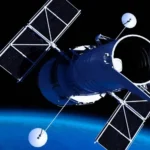Planetary defense is a critical field of study and action focusing on protecting our planet from potential cosmic threats, primarily asteroid and comet impacts. While the chances of a catastrophic impact are rare, the consequences would be devastating. In this article, we will explore the significance of planetary defense, the methods employed to identify and mitigate threats, and the collaborative efforts to safeguard Earth.
The Significance of Planetary Defense
The overarching significance of planetary defense is grounded in the profound responsibility of protecting our planet and its inhabitants from potentially catastrophic cosmic collisions. Although such events are rare in the grand timescale of Earth’s existence, the stakes are immeasurable. By actively preparing for and mitigating the risks posed by near-Earth objects (NEOs), such as asteroids and comets, we ensure our planet’s long-term safety and well-being and exemplify our capacity for proactive stewardship of the fragile blue orb we call home.
The Impact Hazard
The Earth’s history bears witness to the tumultuous consequences of cosmic impacts, some of which have resulted in mass extinctions and radical ecological disruptions. Acknowledging the potential risks posed by NEOs is not an exercise in fear but rather a rational response to an empirically validated phenomenon. By systematically studying these celestial wanderers and actively preparing for potential encounters, planetary defense protects against a catastrophic future impact.
Public Safety and Infrastructure Protection
The ultimate goal of planetary defense is to ensure the safety and well-being of humanity, safeguard critical infrastructure, and preserve the ecological balance of our planet. Beyond the immediate threat to human life, protecting our technological infrastructure, including satellites and communication networks, is paramount. By identifying and tracking hazardous objects in space, we can take proactive measures to prevent potentially catastrophic impacts that could disrupt the delicate fabric of modern civilization.
Detecting Cosmic Threats
At the heart of planetary defense lies the crucial task of detecting and tracking potential cosmic threats, enabling timely response and mitigation strategies.
Sky Surveys and Space Telescopes
Astronomers conduct meticulous sky surveys and deploy space telescopes to identify NEOs systematically. These surveys, scanning the night sky for moving objects, provide a wealth of data that is instrumental in tracking the trajectories of potentially hazardous objects. Technologies like the Large Synoptic Survey Telescope (LSST) promise to enhance our ability to detect and characterize these celestial wanderers further.
Impact Risk Assessment
Scientists conduct rigorous impact risk assessments by calculating NEOs’ orbits, sizes, and potential impact energies. These assessments are the cornerstone of informed decision-making, allowing experts to gauge the threat posed by a particular object and develop tailored mitigation strategies.
Mitigating Potential Threats
Once a hazardous object has been identified and its potential impact assessed, various mitigation strategies can be employed to deflect or neutralize the threat.
Deflection Techniques
Deflection methods encompass a range of strategies, including kinetic impactors that alter an object’s velocity by colliding with it and gravity tractors that use a spacecraft’s gravitational force to subtly change the course of a NEO. These techniques resemble cosmic billiards, nudging an object from its collision course with Earth.
Mitigation Simulations
Sophisticated simulations facilitate the development and validation of mitigation strategies. These simulations enable planetary defense experts to explore various scenarios and assess the effectiveness of different approaches. The knowledge gained from simulations informs decision-making in the event of a real threat, ensuring swift and precise responses.
International Collaboration
Planetary defense is a global endeavor that demands international collaboration, cooperation, and shared resources to address the potential cosmic threats that transcend national boundaries.
The Role of Space Agencies
Space agencies such as NASA, ESA (European Space Agency), and other international counterparts play pivotal roles in planetary defense efforts. These organizations are at the forefront of NEO tracking, risk assessment, and mitigation strategy development. International collaboration allows for the sharing of data, expertise, and resources, ensuring a coordinated response to potential threats.
United Nations Coordination
The United Nations Office for Outer Space Affairs (UNOOSA) promotes international cooperation in planetary defense. Within the United Nations framework, the Committee on the Peaceful Uses of Outer Space (COPUOS) convenes to discuss NEO-related matters and establish guidelines for international collaboration in planetary defense efforts. This diplomatic and regulatory framework facilitates the pooling of global expertise and resources.
Public Awareness and Education
Raising public awareness about planetary defense is a crucial field component, as it engenders support, understanding, and informed engagement in potential cosmic threat mitigation.
Asteroid Day
Asteroid Day, celebrated globally on June 30th, is a poignant reminder of the significance of planetary defense. This annual event encourages discussions, educational programs, and awareness campaigns to inform the public about NEOs, potential threats, and the scientific and technological efforts underway to protect our planet.
Citizen Science Initiatives
Citizen scientists are integral to planetary defense efforts. Public participation in NEO identification and tracking programs, often facilitated through citizen science initiatives, broadens the network of observers and engages individuals in the scientific process. These programs empower the public to contribute meaningfully to planetary defense and foster a sense of shared responsibility.
Conclusion
Planetary defense is a testament to humanity’s capacity for foresight, cooperation, and stewardship of Earth and its future. While the likelihood of a catastrophic cosmic impact remains low, the consequences are so dire that they necessitate vigilant monitoring and preparedness. Through international collaboration, advanced technology, and public awareness initiatives, we can systematically reduce the risks associated with near-Earth objects and ensure the long-term safety of our planet.
In planetary defense, humanity stands united in its commitment to protecting our home world from the unpredictable forces of the cosmos. This exemplifies our capacity for proactive engagement and our determination to shield Earth from potential cosmic threats.












